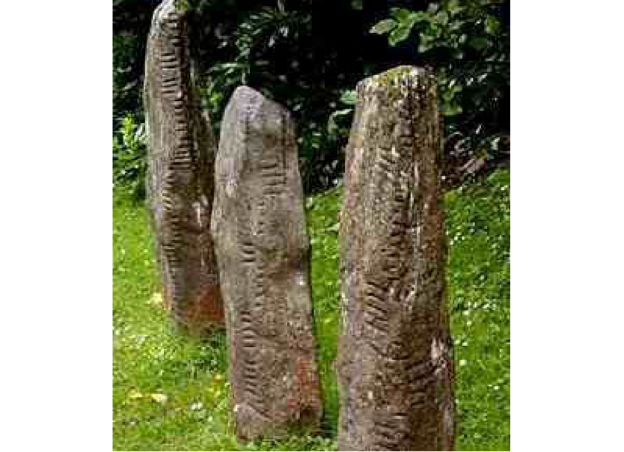Gerry Loose: Eight further poems in ogham script with a note on poetics and translation

Church of the 3 Brethren Lochgoilhead
little saint of whitethorn
little quencher of wolf spark
welcome to the burial mounds
dear confessor of blood-red berries
sweet dweller of beehive cell
oaks make good gallow-trees
meagre
my heart
Blackwaterfoot, Arran, King’s Cave #1
son: to leave
friend: to stroll among trees
work: to ride horses
killing: to be swift
father: to shelter the hunted
Blackwaterfoot, Arran, King’s Cave #2
skinsilver birch
rowan of pillage
heather the udder brusher
poplar the horse trembler
oak of hill & adze
answer
song
Scoonie, Fife
no name for them
they grow deep within
tree proud bush proud
urgent they ’re allies
though they groan
shrivel in the hunt
still bigger than a horse
Abernethy
coltsfoot the apple that suckles
sun hoof the vine that strangles
sun horse the yew that sickens
Pool
manifold the wheel
honey bees dancing
blush of the dying
breath of horses
wood brands burning
warriors at the breast
trees green leafing
world wheel whirling
Inchyra
begin with honey
& fellowship of trees
one third of a spear
& a shroud
return salmon
return sun
return spring well
bees are dying
Mains of Afforsk
beauty’s a boast
& kinship with saplings
with a glow of anger
& warriors’ gear
cherished hazel
& grace disappear
cypher unknown
& wisdom undone
NOTES
Writes Gerry Loose, qua translator:
“Ogham is the [rune-like] script used for inscriptions on stone during the fourth to eighth centuries CE, in the earliest known form of Gaelic. It comprises strokes across or to either side of a central stem line and is found on monoliths mainly in Ireland, with a few in Scotland, mostly in Gaelic but some in conjunction with Pictish symbols, which may be in that language …
Ogham is also called the tree alphabet, since the name of a tree (or plant) has been ascribed to each Gaelic letter thus: beith, luis, nin — birch, herb, ash … and so on. An alphabet végétal …
Whatever the method of reading this script, it is steeped in the secrecy of the literate over the non-literate; it’s always regarded as the property of the high poets, the early medieval fili of Ireland, who would spend many years memorizing 150 varieties of ogham. With the above, it’s possible to see the poetic possibilities, whatever ogham script is used …
Because the letters on the inscribed stones are sometimes doubled up, I have used this for emphasis. Because, also, not all words in Gaelic have precise English equivalents (for example seanachas has overtones of biography and of tradition and of genealogy and of history and of language), I have moved between phrase oghams to use words I think best work in a given poem. Where these will not do, I have used other, appropriate translations of the Gaelic, the stone, and the landscape itself to make a viable English poem from the ogham.”
N.B. Three additional ogham poems can be found on Poems and Poetics for February 5, 2015. Loose also notes that the titles of the poems posted above are all place names.
Poems and poetics